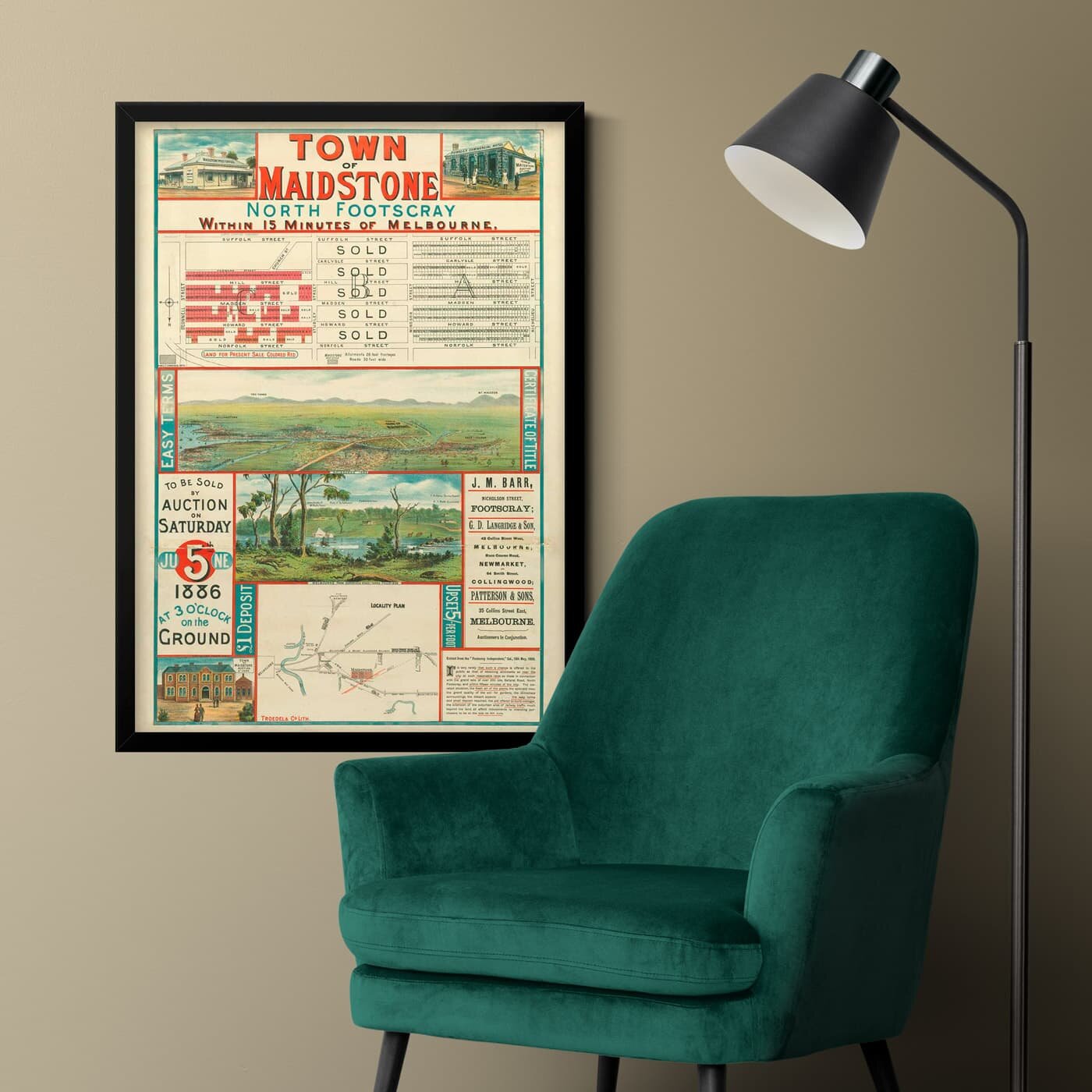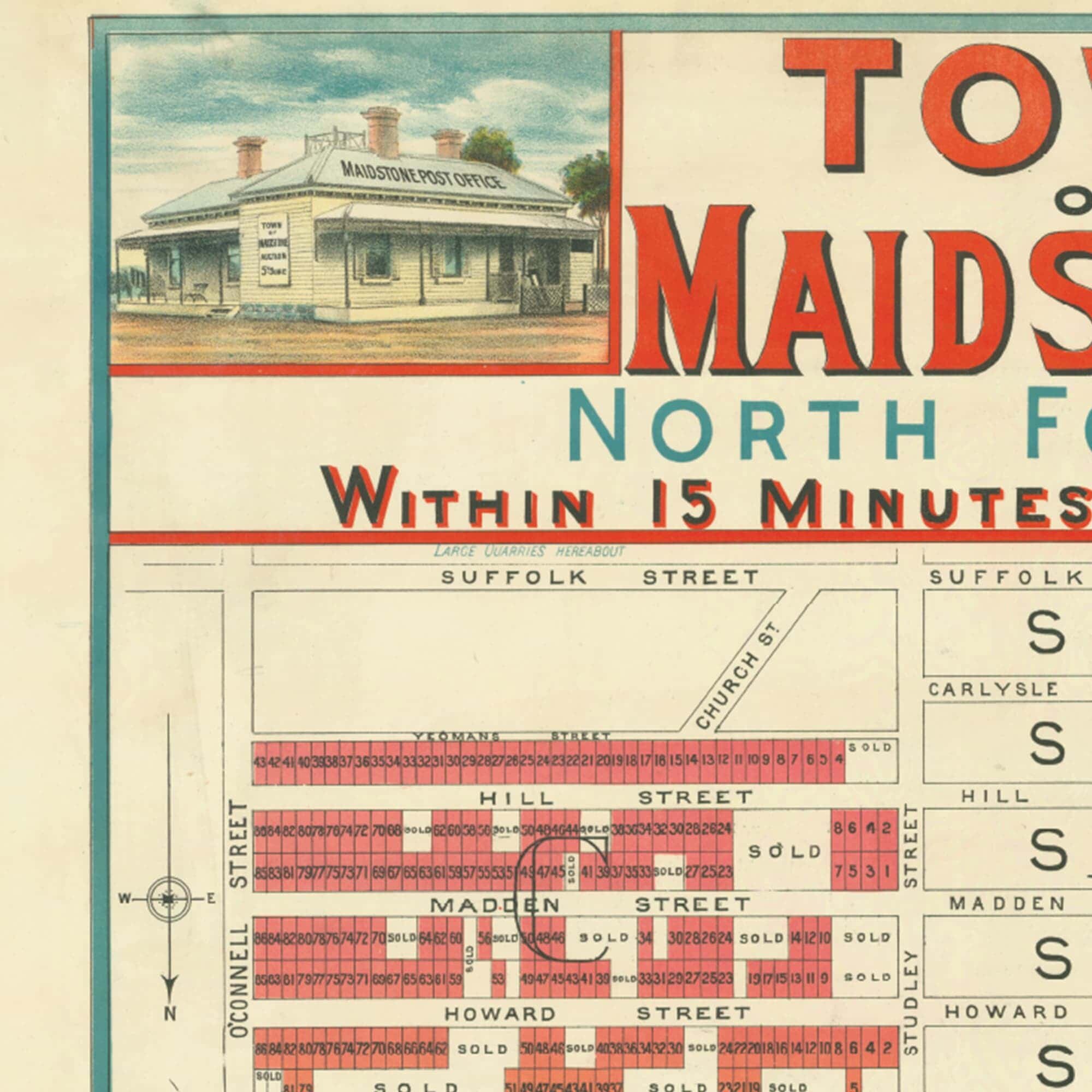Cart
undefined
ENJOY POSTER & CALENDAR SHIPPING ON US







This is by far the gold standard of all estate auctions advertising from the 1880s that we have seen. Full colour illustrations of the Post Office and Powell’s Commercial Hotel, landscape scene paintings, a location map, building scenes and wonderful text colours. I wish they all were like this. Features streets: Suffolk Street, Carlysle Street, Hill Street, Madden Street, Howard Street, Studley Street, Windsor Street.
By studying census returns of 1861 there were 47 houses at Maidstone, most of them timber, and seven tents. Although a traveller passing through on the train in 1860 noticed only 'some half-dozen wooden houses standing in gardens surrounded with stone walls for hedges', evidence from rate books suggested that many of the residents worked in manufacturing, rented their homes and often had difficulty paying the rates.
It is unlikely that a great proportion of the 3,500 allotments at Maidstone were built upon in the nineteenth century. It has been suggested that many of the blocks were purchased by miners in central Victoria who never actually saw them. Certainly, when the Victorian Housing Commission came to redevelop the area in the 1950s, it found that 'many titles were obscure, since they had been originally been sold in unusual and sometimes shady circumstances'.
In the 1880s, there were renewed attempts to market parts of this estate that had not sold. This is one of those later attempts.
This is by far the gold standard of all estate auctions advertising from the 1880s that we have seen. Full colour illustrations of the Post Office and Powell’s Commercial Hotel, landscape scene paintings, a location map, building scenes and wonderful text colours. I wish they all were like this. Features streets: Suffolk Street, Carlysle Street, Hill Street, Madden Street, Howard Street, Studley Street, Windsor Street.
By studying census returns of 1861 there were 47 houses at Maidstone, most of them timber, and seven tents. Although a traveller passing through on the train in 1860 noticed only 'some half-dozen wooden houses standing in gardens surrounded with stone walls for hedges', evidence from rate books suggested that many of the residents worked in manufacturing, rented their homes and often had difficulty paying the rates.
It is unlikely that a great proportion of the 3,500 allotments at Maidstone were built upon in the nineteenth century. It has been suggested that many of the blocks were purchased by miners in central Victoria who never actually saw them. Certainly, when the Victorian Housing Commission came to redevelop the area in the 1950s, it found that 'many titles were obscure, since they had been originally been sold in unusual and sometimes shady circumstances'.
In the 1880s, there were renewed attempts to market parts of this estate that had not sold. This is one of those later attempts.
This is by far the gold standard of all estate auctions advertising from the 1880s that we have seen. Full colour illustrations of the Post Office and Powell’s Commercial Hotel, landscape scene paintings, a location map, building scenes and wonderful text colours. I wish they all were like this. Features streets: Suffolk Street, Carlysle Street, Hill Street, Madden Street, Howard Street, Studley Street, Windsor Street.
By studying census returns of 1861 there were 47 houses at Maidstone, most of them timber, and seven tents. Although a traveller passing through on the train in 1860 noticed only 'some half-dozen wooden houses standing in gardens surrounded with stone walls for hedges', evidence from rate books suggested that many of the residents worked in manufacturing, rented their homes and often had difficulty paying the rates.
It is unlikely that a great proportion of the 3,500 allotments at Maidstone were built upon in the nineteenth century. It has been suggested that many of the blocks were purchased by miners in central Victoria who never actually saw them. Certainly, when the Victorian Housing Commission came to redevelop the area in the 1950s, it found that 'many titles were obscure, since they had been originally been sold in unusual and sometimes shady circumstances'.
In the 1880s, there were renewed attempts to market parts of this estate that had not sold. This is one of those later attempts.